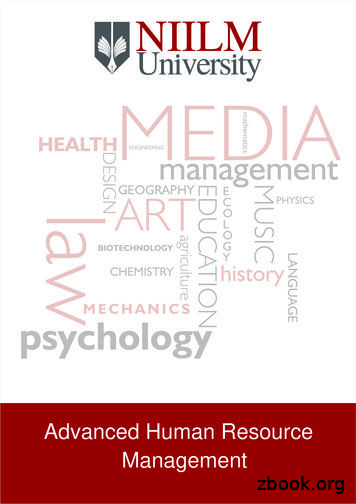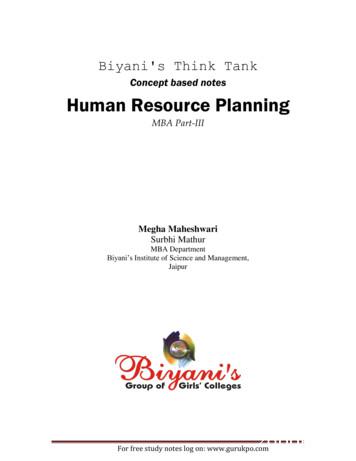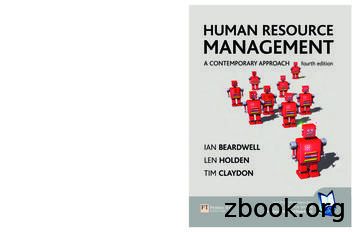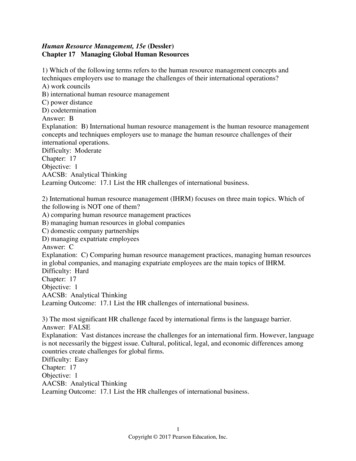Human Resource Management And Human Resource Development .
Creighton Journal of Interdisciplinary LeadershipVol. 1, No. 2, November 2015, pp. 120 – 129COMPREHENSIVE REVIEWHuman resource management and human resource development:Evolution and contributionsNicole Richman, MBAGeorge Fox University, doctoral student, nrichman12@georgefox.eduAbstract. Research agrees that a high performance organization (HPO) cannot exist without an elevated valueplaced on human resource management (HRM) and human resource development (HRD). However, acomplementary pairing of HRM and HRD has not always existed. The evolution of HRD from its roots in humanknowledge transference to HRM and present day HRD activities reveals that environmental, social, and politicalinfluences have escalated the need for organizations to focus employee development in the areas of flexibility,innovation, and capability. The following review illustrates the importance of HRM and HRD to organizationalleadership. Furthermore, the research examined builds a close association between the attributes of a HPO and theskills transferred through an effective collaboration of HRM and HRD activities.Keywords: high performance organization (HPO), human resource management (HRM), human resourcedevelopment (HRD)IntroductionFrom financial transactions to operational decisions and beyond, the core of everybusiness function relies on an organization’s greatest asset: its human resources. Assuch, human resources boast significant responsibility for the success or failure of anorganization (de Waal, 2007; Haslinda, 2009). The value of human resources is not alwayswidely apparent. In fact, present day perception frequently limits human resourcemanagement (HRM) and human resource development (HRD) to recruitment, compensation,and legalities of managing a workforce (Haslinda, 2009). This review identifies the emergentvalue of human resources, the transformation from education and training to HRD, and therelative importance of HRD to organizational leaders. Specifically, it outlines the reliance ofhigh performance organizations (HPOs) on HRM and HRD, concluding with the present daycritical issues facing HRM and HRD.The acronyms HRM, HRD and HPO can be, and often are, confused (Haslinda, 2009).However, to examine their historical and future implications, the differentiation of theacronyms must first be understood. Researchers have adopted a multitude of definitions forthe same acronyms. The definitions vary based on country of origin, global perspective, orindividual theorist (Haslinda, 2009). The definitions listed below are selected as thefoundational meanings for this paper because each one encompasses the overarching themesacross literature.Human Resource Management (HRM)Haslinda (2009) cites HRM as the “process of managing human talents to achieveorganization’s objective” (Haslinda, 2009, p. 180). Recruitment of talent, benefitmanagement, labor relations, and other legalities such as employee safety and health are all 2015 N. RichmanCreighton Journal of Interdisciplinary LeadershipDOI: http://dx.doi.org/10.17062:CJIL.v1i2.19
HRM and HRD: Evolution and contribution 121encompassed in the process of HRM (Haslinda, 2009). As discussed further, HRM as aprocess is a critical distinction from HRD.Human Resource Development (HRD)Converse to the process-based HRM, HRD is a series of activities that support behavioralchange and learning opportunities for employees (Haslinda, 2009). HRD activities aim todevelop employee skills and resilience to the current and future demands of the organization.The overall objective of HRD activities is to achieve high performance (Haslinda, 2009).Haslinda (2009) provides for specific examples of development activities to include trainingand development, feedback and appraisal, career planning and development, and changemanagement.High Performance Organization (HPO)Literature varies widely in the definition of a HPO. Definitions tend to revolve aroundspecific achievements, financial outcomes, customer satisfaction, or productivity (de Waal,2007).A High Performance Organization is an organization that achieves financial results thatare better than those of its peer group over a longer period of time, by being able to adaptwell to changes and react to these quickly, by managing for the longer term, by setting upan integrated and aligned management structure, by continuously improving its corecapabilities, and by truly treating the employees as its main asset. (de Waal, 2007, p. 3)Because capability, adaptation, and management are core human resource functions, thispaper restates de Waal’s (2007) definition of an HPO as the sought result from effective HRMprocesses and HRD activities.History and EvolutionTheorists such as Haslinda (2009) and Torraco, (2009), place the beginning of HRM inEngland during the 1800s. Research suggests, that formal HRD activities began to appear inthe United States during the Industrial Revolution (Sleight, 1993). Overall literature dateshuman development to the earliest days of mankind when training and learning wereprocesses of survival and subsistence (Haslinda, 2009; Sleight, 1993; Torraco, 2009).Throughout such literature, a path of labor necessity, revolutions, and evolution of thoughtcan be drawn from the earliest transference of knowledge and skills to modern day HRDactivities.Human DevelopmentThis paper consolidates literature to define learning, or development, as a cyclical processwhich starts with a trigger or a problem. Russ-Eft, Watkins, Marsick, Jacobs, & McLean(2014) suggest that various perspectives aid in understanding and analyzing the problem orsituation to develop alternative solutions. During and after implementation of one or morealternatives, the outcomes create new knowledge which is pooled for future decisions (RussEft et al., 2014). Torraco (n.d) suggests the pattern of learning and development can be tracedback to the earliest days of man. For example, in more primitive periods, the skills andknowledge transferred from one human to another consisted of those needed to provide tools,food, and shelter for survival (Torraco, 2009). However, the literature disagrees with thefoundational forces which exposed labor division. Marx proposes the economic desire forprivate property and social class exposed natural skill differences and proficiencies (as citedin North, 1969). In contrast, Torraco (2009) argues as tools developed to more easily providesurvival needs, the natural skills and abilities of human labor became exposed resulting in anatural division of skill crafts, such as carpentry and weaving. Regardless of the foundational 2015 N. RichmanCreighton Journal of Interdisciplinary LeadershipDOI: http://dx.doi.org/10.17062:CJIL.v1i2.19
122 N. Richmanforce that drove the division of labor, the separation of skills and crafts led to the cooperationof people for goods and services as well as transference of skills and craft (North, 1969;Torraco, 2009).Communication, language, and professional skills became evident in some of the earliestEgyptian written records dating back to 3000 and 500 B.C.E. (Tokuhama-Espinosa, 2011).While historical evidence suggests the learning curve during mankind’s beginning was steep,it remained modest and primitive until the Greek and Roman eras (Tokuhama-Espinosa,2011; Torraco, 2009). Specifically, the comprehensive history provided by Torraco (2009)concludes the more sophisticated development was the result of Greek and Roman politicaland social agendas to create learning institutions. The Greeks first recognized education as anecessity to human development, which resulted in the permanent imprint of Greekphilosophy on education (Tokuhama-Espinosa, 2011; Torraco, 2009). According to theGreeks, the type of work training and education one received reflected social status. Torracoillustrates the Greek culture through Socrates’ stance on educational philosophy. In short,Socrates believed that manual labor destroyed the body and left no time for development ofthe mind and soul. Therefore, only the lower class Greek population received apprenticeshipand trade training. Upper-class youths received the more distinguished arts and humanitiesscholarship (Tokuhama-Espinosa, 2011; Torraco, 2009).Between late mid-400 B.C. to early 300 B.C., human development philosophy expandedsignificantly from trade and arts education. Greek philosophers Plato and Aristotle joinedSocrates in contributing significant insight and educational thought to human development.Socrates based his Socratic Method on inquisition and the need to find the underlying truth toreason (Torraco, 2009). In The Republic, Plato introduced a society with an elaborate systemof knowledge, politics, and educational theory (Dillon, 2004). Aristotle systemizedknowledge through the development of scientific inquiry methodology. Organon, the series oftreatises authored by Aristotle, outline the principle guides to analyze reason and logicscientifically (“Aristotle,” n.d.; Torraco, 2009). The Politics extended exemplification ofAristotle’s belief on the ways that education would enrich human development (Torraco,2009).By the middle ages, beginning early 300s to early 1300s, Christianity held the greatestinfluence in education and training. Specifically, the responsibility for institutional controlrested with the Church. “In the wake of the decadent Romans and barbarous Goths andVandals, there was a great need for the structure and moral discipline that Christianityoffered” (Torraco, 2009, p. 6). Torraco (2009) argues that Christianity became instrumental incultivating the curriculum for secondary and higher education, much of which extendedbeyond the medieval period. Christianity incorporated the spiritual value of labor, thusparadigmatically shifting the Greek value for mental growth to the Roman value for tradesand labors (Torraco, 2009). In fact, the academic learning fell almost entirely to the Christianmonasteries while manual labor and mechanical arts saw significant advancement. The shiftfrom mental growth to laborious trades was not necessarily a solid split of values (Swanson &Holton, 2009). Rather, the Renaissance era, 1400 – 1800, introduced inventions, ideas, andart, which continue to underlie technological advancements today. Much of moderntechnology can be traced back to the culmination of trade practices and a deepening thirst forknowledge (Swanson & Holton, 2009).Possibly the most interesting findings in human development came from the socialmovements of the past two centuries. The social movements, such as labor organization, civilrights, and religious freedom, proved relentlessly that training and development is not aboutthe organization of an idea rather the cyclical process by which an idea is founded, analyzed,rationalized, implemented, and learned from (Callahan, 2013). In the more recent era, humandevelopment and education has centered on the individual goals and desire for achievement.The transition from external pressures to internal reflection altered the higher educationprogram. Adult education programs aim at providing education directed at specific career
HRM and HRD: Evolution and contribution 123paths. Human development has thus transformed to a chosen path versus one directed byenvironmental need or spiritual leadership (Jacobs, 2014).Research in human development appears to have gone full circle to the primitive era oflearning through experiences and Greek style growth muffled by dictated values. Modernliterature agrees that learning through work programs and engagement in growth activities,offers deep experiences and grounded cognition (Gold & Bratton, 2014). Specifically, Goldand Bratton (2014) contend the context of knowledge gain is derivative of a focusedprofessional environment which ultimately best serves the organization. As a result, thetransference of knowledge to new behaviors or ideas is stifled by the purpose or direction ofthe organization (Gold & Bratton, 2014). Thus, HRM and HRD practice emerged in an effortto open the learning process through a convergence of practical needs and a thirst forknowledge.Human Resource ManagementSome theorists contend modern business management stems from five periods, which can becharacterized by external forces, that ultimately altered the way management responded overthe long term (Darmody, 2007; Liebhold, 1995; Nadworny, 1957). The five periods includethe industrial growth, scientific management, human relations, systems, and organizationalculture (Rodríguez-Ruiz, 2014). However, other theorists such as Sleight (2009), extendHRM earlier, directly connecting it to the trade period and human development. While anofficial HRM milestone may not be defined, the precluding events are clear. The craftsmanand trade apprenticeship era extended into the early 1800s and fostered the introduction of theIndustrial Revolution in the late 1800s. According to Darmody (2007) and Liebhold (1995)theorists such as Fredrick Taylor and Frank and Lillian Gilbreth emerged with a goal toincrease productivity through process management of the organization’s human resources.Taylor and the Gilbreths introduced concepts of efficient workflow and optimal conditions(Darmody, 2007; Liebhold, 1995; Nadworny, 1957).The new obsession with worker performance combined with the rise of largeorganizations and government intervention forced companies to develop formal personnelmanagement departments. By 1945, during the World War, the official term personnelmanagement (PM) had been coined (Haslinda, 2009). While Haslinda (2009) supports PMaligns with the development of HRM, there are differences between the functions of PM andHRM. PM originally functioned to hire and terminate employees and maintain theorganization standards in accordance to the trade unions (Haslinda, 2009). Thus, PM waslargely a reactive set of processes. To the contrary, Haslinda (2009) argues HRM proactivelyaddresses organizational needs by obtaining, organizing, and managing human
In fact, present day perception frequently limits human resource management (HRM) and human resource development (HRD) to recruitment, compensation, and legalities of managing a workforce (Haslinda, 2009). This review identifies the emergent value of human resources, the transformation from education and training to HRD, and the
Human Resource Management Human Resource Policy QUADRANT-I Module 4: Human Resource Policy 1. Learning Outcome 2. Definition 3. Employee understanding on HR Policy 4. Benefits of policy 5. Specific Personal policies 6. Responsibility for policy making 7. Formulation of Human Resource Policy 8. Principles 9. Procedures 10. Programs 11. Summary 1.
Human Resource Management Question Answer Bank MBA-203 Q.1 What is Human Resource Management Human Resource Management is a process, which consists of four main activities, namely, acquisition, development, motivation, as well as maintenance of human resources. Scott, Clothier and Spriegel have defined Human Resource Management as that
1.1.2 Evolution of Human Resource Management 1.1.3 Human Resource Management: Nature 1.1.4 Human Resource Management: Scope 1.1.5 Human Resource Management: Objectives 1.2 Functions of HRM 1.3 Growing Importance of HRM Functions 1.3.1 Factors Contributing to the Growing Importance of HRM 1.4 Concepts and Essential of Management
Ans Human resource planning can be defined as the process of identifying the number of people required by an organization in terms of quantity and quality. All human resource management activities start with human resource planning. So we can say that human resource planning is the principle/primary activity of human resource management.
human resource functions while keeping them satisfied in their work. It covers a wide range of chapters on human resource management such as human resource functions, performance management and human resource development and empowerment. This module serves the purpose of a resource handbook for carrying out training on Human Resource Management
Human resource management: the state of the debate 24 Summary 27 Activity 28 References and further reading 29 2 Strategic human resource management Nicky Golding 32 Objectives 32 Introduction to strategic human resource management 32 Understanding the business context 34 Approaches to the strategy-making pr
B) international human resource management C) power distance D) codetermination Answer: B Explanation: B) International human resource management is the human resource management concepts and techniques employers use to manage the human resource challenges of their international
(100% total) HSC course core modules (75% total) Resource Management Basic concepts of resource management. -Indicative course time: 20% . . Fundamental concepts of resource management . 0. Influences on resource management . 0. Effective resource management . Core 1: Resource Management . Students learn about:























